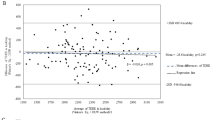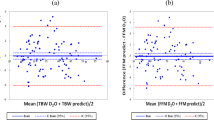Abstract
BACKGROUND: In Latin American and Caribbean countries such as Chile, Mexico and Cuba, the population over 60 y has increased steadily. In this age group, there is scarce information about body composition, particularly for those living in rural areas.
OBJECTIVE: The purpose of this study was to determine body composition in free-living and healthy elderly subjects >60 y from rural areas of Chile, Cuba and Mexico using deuterium oxide dilution and bioelectrical impedance (BIA) and to develop and cross-validate a predictive equation for this group of subjects by BIA for future use as a field technique.
SUBJECTS: The study included 133 healthy subjects (73 males and 60 females) >60 y from rural regions of Cuba, Chile and Mexico.
MEASUREMENTS: Total body water, body weight, height and other anthropometric and BIA variables (resistance and reactance) were measured.
METHODS: Total body water was determined by deuterium oxide dilution, and fat-free mass (FFM)/fat mass were derived from this measurement. The total sample was used in a split-sample internal cross-validation. BIA and other anthropometric variables were integrated to multiple regression model to design the best predictive equation, which was validated in the other sample. ANOVA, multiple regression and Bland and Altman's procedure were used to analyze the data.
RESULTS: Body weight, percentage of fat and fat-free mass were lower in the Cuban men and women compared with Chilean and Mexican men and women. The best predictive equation of the FFM was: FFM kg=(−7.71+(H2/R × 0.49)+(country or ethnicity × 1.12)+(body weight × 0.27)+(sex × 3.49)+(Xc × 0.13)), where H2 is height2 (cm); R is resistance (Ω); country: Chile=1, Mexico=2 and Cuba=3; sex: women=0 and men=1; body weight (kg) and Xc is reactance (Ω). R2 was 0.944 and the root mean square error (RMSE) was 2.08 kg. The mean±s.d. of FFM prediction was 44.2±9.2 vs 44.6±10.1. The results of cross-validation showed no significant difference with the line of identity, showing that the predicted equation was accurate. The intercept (=–0.32) was not significantly different from zero (P=0.89) and the slope (=1.02) not significantly different from 1.0 (P>0.9). The R2 was 0.86, RMSE=3.86 kg of FFM and the pure error was 3.83.
CONCLUSION: The new BIA equation is accurate, precise and showed good agreement. The use of this equation could improve the estimates of body composition for the elderly population for these regions, as well as enhancing the opportunity to conduct studies in the elderly population from Latin America.
This is a preview of subscription content, access via your institution
Access options
Subscribe to this journal
Receive 12 print issues and online access
$259.00 per year
only $21.58 per issue
Buy this article
- Purchase on Springer Link
- Instant access to full article PDF
Prices may be subject to local taxes which are calculated during checkout


Similar content being viewed by others
References
Esparza J, Fox C, Harper IT, Bennett PH, Schulz LO, Valencia ME, Ravussin E . Daily energy expenditure in Mexican and USA Pimas Indians: low physical activity as a possible cause of obesity. Int J Obes Relat Metab Disord 2000; 24: 55–59.
Valencia ME, Bennett PH, Ravussin E, Esparza J, Fox C, Schulz LO . The Pimas Indian in Sonora, México. Nutr Rev 1999; 11: S55–S58.
González S, Alemán-Mateo H, Hernández-Triana M, Salazar G, Sánchez V, Basabe B, Valencia ME . Total energy expenditure in elderly subjects from a rural community in Cuba, by questionnaire and resting metabolic rate (factorial method), compared with the double-labelled water method as gold standard [Abstracts]. Ann Nutr Metab Suppl 2001; 45: 354.
Torún B . Patrones de actividad física en América Central. In: Peña M, Bacallao J (eds). La Obesidad en la Pobreza. Un nuevo reto para la salud pública, Organización Panamericana de la Salud; 2000. pp 33–43.
Alemán-Mateo H, Esparza J, Mauro E . Valencia. Antropometría y composición corporal en personas mayores de 60 años: importancia de la actividad física. Salud Publica Mex 1999; 41: 309–316.
Levenhagen DK, Borel MJ, Welch DC, Piasecki JH, Piasecki DP, Chen KY, Flakoll PJ . A comparison of air displacement plethysmography with three other techniques to determine body fat in healthy adults. JPEN 1999; 23: 293–299.
Schoeller DA . Changes in total body water. Am J Clin Nutr 1989; 50: 1176–1181.
Fuller NJ, Sawyer MB, Laskey MA, Paxton P, Elia M . Prediction of body composition in elderly men over 75 years of age. Ann Hum Biol 1996; 23: 127–147.
Goran MI, Toth MJ, Poehlman ET . Assessment of research-based body composition techniques in healthy elderly men and women using the 4-compartment model as a criterion method. Int J Obes Relat Metab Disord 1998; 22: 135–142.
Novak LP . Aging, total body potassium, fat-free mass, and cell mass in males and females between ages 18 and 85 years. J Gerontol 1972; 27: 438–443.
Forbes GB, Halloran E . The adult decline in lean body mass. Hum Biol 1976; 48: 162–173.
Steen B . Body composition and aging. Nutr Rev 1988;46:45–51.
Mazess RB . On aging bone loss. Clin Orthop Res 1982; 165: 239–252.
Heaney RP, Gallagher JC, Johnston CC, Neer R, Parfitt AM, Whedon GD . Calcium nutrition and bone health in the elderly. Am J Clin Nutr Suppl 1982; 36: 986–1013.
Noppa H, Andersson M, Bengtsson C, Bruce A, Isaksson B . Body composition in middle-aged women with special reference to the correlation between body fat mass and anthropometric data. Am J Clin Nutr 1979; 32: 1388–1395.
Durnin JV, Womersley J . Body fat assessed from total body density and its estimation from skinfold thickness: measurements on 481 men and women aged from 16 to 72 years. Br J Nutr 1974; 32: 77–97.
Borkan GA, Hults DE, Gerzof SG, Robbins AH . Comparison of body composition in middle-aged and elderly males using computed tomography. Am J Phys Anthropol 1985; 66: 289–295.
Ritz P . Body water spaces and cellular hydration during healthy aging. Ann NY Acad Sci 2000; 904: 474–483.
Katz S, Downs TD, Cash HR, Grotz RC . Progress in development of the index of ADL. Gerontologist 1970; 10: 20–30.
Euronut SENECA investigators. Life-style: physical activities and activities of daily living. Eur J Clin Nutr Suppl 1991; 45: 139–151.
Ashworth L, Gibb I, Alberti KGMM . HemoCue: evaluation of a portable photometric system for determining glucose in whole blood. Clin Chem 1992; 38: 1479–1482.
WHO. Diabetes mellitus. Report of a WHO Study Group. Technical Report Series No. 727. World Health Organization, Geneva: 1985.
World Health Organization (WHO). Arterial hypertension. Technical Report No. 628. Expert Committee Report, Geneva, 1978.
Durnin JVGA . Anthropometric methods for assessing nutritional status. In: Horowitz A, Macfadyen DM, Munro H, Scrimshaw NS, Steen B, Williams TF (eds). Nutrition in the elderly. Oxford University Press: Oxford; 1989. pp 15–32.
Fox C, Esparza J, Nicolson M, Bennett PH, Schulz LO, Valencia ME, Ravussin E . Plasma leptin concentrations in Pima Indians living in drastically different environments. Diabetes Care 1999; 22: 413–417.
Fox CS, Esparza J, Nicolson M, Bennett PH, Schulz LO, Valencia ME, Ravussin E . Is a low leptin concentration, a low resting metabolic rate, or both the expression of the ‘thrifty genotype’ ? Results from Mexican Pima Indians. Am J Clin Nutr 1998; 68: 1053–1057.
Scrimgeour CM, Rollo MM, Mudambo MKT, Handley LL, Prosser SJ . A simplified method for deuterium/hydrogen isotope ratio measurements on water samples of biological origin. Biol Mass Spectrom 1993; 22: 383.
Edelman IS, Leibman J . Exchange of water between blood and tissues: characteristics of deuterium oxide equilibration in body water. Am J Physiol 1952; 171: 279–296.
Forbes GB . Human body composition. In: Growth, aging, nutrition, and activity. Springer-Verlag; New York; 1987.
Pace N, Rathburn EN . Studies on body composition. III: the body water and chemically combined nitrogen content in relation to fat content. J Biol Chem 1945; 158: 685–691.
Bland JM, Altman DG . Statistical methods for assessing agreement between two methods of clinical measurement. Lancet 1986; 1: 307–310.
Alemán Mateo Heliodoro. Nivel de actividad física, requerimiento de energía y composición corporal en personas activas de la tercera edad, residentes de una región rural de Cuba, Chile y México. Tesis de Doctorado, CIAD, A.C., Hermosillo, México, 2000.
Porrata C, Rodríguez-Ojeda A, Jiménez S . La transición epidemiológica en Cuba. In: Peña M, Bacallao J (eds). La Obesidad en la Pobreza. Un nuevo reto para la salud pública, Organización Panamericana de la Salud; 2000. pp 57–72.
Bouchard C, Després JP, Mauriege P . Genetic and nongenetic determinants of regional fat distribution. Endocr Rev 1993; 14: 72–93.
Deurenberg P, van der Kooy K, Leenen R, Evers P, Hulshof T . Assessment of body composition by bioelectrical impedance in a population aged >60 y. Am J Clin Nutr 1990; 51: 3–6.
Roubenoff R, Baumgartner RN, Harris TB, Dalla GE, Hannan MT, Economos ChD, Stauber PM, Wilson PWF, Kiel DP . Application of bioelectrical impedance analysis to elderly population. J Gerontol A. 1997; 52: M129–M136.
Bussolotto M, Ceccon A, Sergi G, Giantin V, Beninca P, Enzi G . Assessment of body composition in elderly: accuracy of bioelectrical impedance analysis. Gerontology 1999; 45: 39–43.
Dupler TL, Tolson H . Body composition prediction equations for elderly men. J Gerontol A 2000; 55: M180–M184.
Kyle UG, Genton L, Karsegard L, Slosman DO, Pichard C . Single prediction equation for bioelectrical impedance analysis in adults aged 20–94 years. Nutrition 2001; 17: 248–253.
Deurenberg P, Saris WHM, Voorrips LE, van Staveren WA . The assessment of body composition in the elderly. Age Nutr 1993; 4: 34–39.
Broekhoff C, Voorrips MP, Witvoet GA, van Staveren WA, Deurenberg P . Relative validity of different methods to assess body composition in apparently healthy elderly women. Ann Nutr Metab 1992; 36: 148–156.
Acknowledgements
This study was supported by CONACYT (25728-M) from Mexico. We thank the volunteers of this study and Inocencio Higuera C, Juan P Camou, Erik Díaz B, Ramón Figueroa, Soledad Figueroa, Osmany Cienfuegos and José Ramón Porrata Mauri. We are also indebted to Julián Esparza Romero, María Esther Hernández, Ingrid Rolón, Rocío Berlangas, Milagros Marcia Velásquez, Jimmy Hernández, Ana Cristina Gallegos Aguilar, Nayeli Macías Morales, María de los Angeles Sánchez and Alejandrina Cabrera for their technical assistance. We appreciate Silvia Y Moya, Ana María Calderón and Elaine Rush for their valuable suggestions and comments on the manuscript.
Author information
Authors and Affiliations
Corresponding author
Rights and permissions
About this article
Cite this article
Valencia, M., Alemán-Mateo, H., Salazar, G. et al. Body composition by hydrometry (deuterium oxide dilution) and bioelectrical impedance in subjects aged >60 y from rural regions of Cuba, Chile and Mexico. Int J Obes 27, 848–855 (2003). https://doi.org/10.1038/sj.ijo.0802315
Received:
Revised:
Accepted:
Published:
Issue Date:
DOI: https://doi.org/10.1038/sj.ijo.0802315
Keywords
This article is cited by
-
Optical imaging of metabolic dynamics in animals
Nature Communications (2018)
-
Bioelectrical impedance with different equations versus deuterium oxide dilution method for the inference of body composition in healthy older persons
The Journal of nutrition, health and aging (2012)
-
Prediction of fat-free mass by bioelectrical impedance analysis in older adults from developing countries: A cross-validation study using the deuterium dilution method
The Journal of nutrition, health and aging (2010)
-
Effect of fluid and food intake on the body composition evaluation of elderly persons
The Journal of nutrition, health and aging (2009)
-
Body fat measurement by bioelectrical impedance and air displacement plethysmography: a cross-validation study to design bioelectrical impedance equations in Mexican adults
Nutrition Journal (2007)



